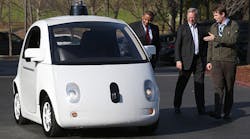SAN FRANCISCO — Google’s self-driving prototype cars have taken to streets in the Silicon Valley city of Mountain View, the company announced Thursday.
The move comes after Google’s internal testing of the bubble-shaped vehicle over the past year and more extensive experience with technology adapted for existing cars.
“We want to understand what it really means to have self-driving vehicles in the world — both how people in the community perceive and interact with them, and what the practical realities are for us in operating and maintaining them,” Google said in a released statement.
Prototype cars built from the ground up to get around safely without human drivers join Google’s fleet of Lexus vehicles augmented with sensors and other computing gadgetry to manage autonomously on roads.
The prototypes will have “safety drivers” who can take over using manual controls if needed, according to Google.
“We’ve had 20-plus Lexus vehicles driving on Mountain View city streets for the last few years, but the arrival of our new self-driving vehicle prototypes marks the start of a new phase of our project,” Google said.
The Google car uses the same technology as its fleet of Lexus SUVs which has logged more than 1 million miles without a major collision.
In Google’s home town of Mountain View, speeds will be limited to 25 mph and “during this next phase of our project, we’ll have safety drivers aboard with a removable steering wheel, accelerator pedal, and brake pedal that allow them to take over driving if needed,” according to the head of the project.
Google has defended the safety record of its self-driving cars, saying that they were not at fault in any of the dozen or so accidents they have been involved in. Most of the collisions involved self-driving cars being hit in the rear by vehicles driven by people, according to the tech titan.
Copyright Agence France-Presse, 2015



